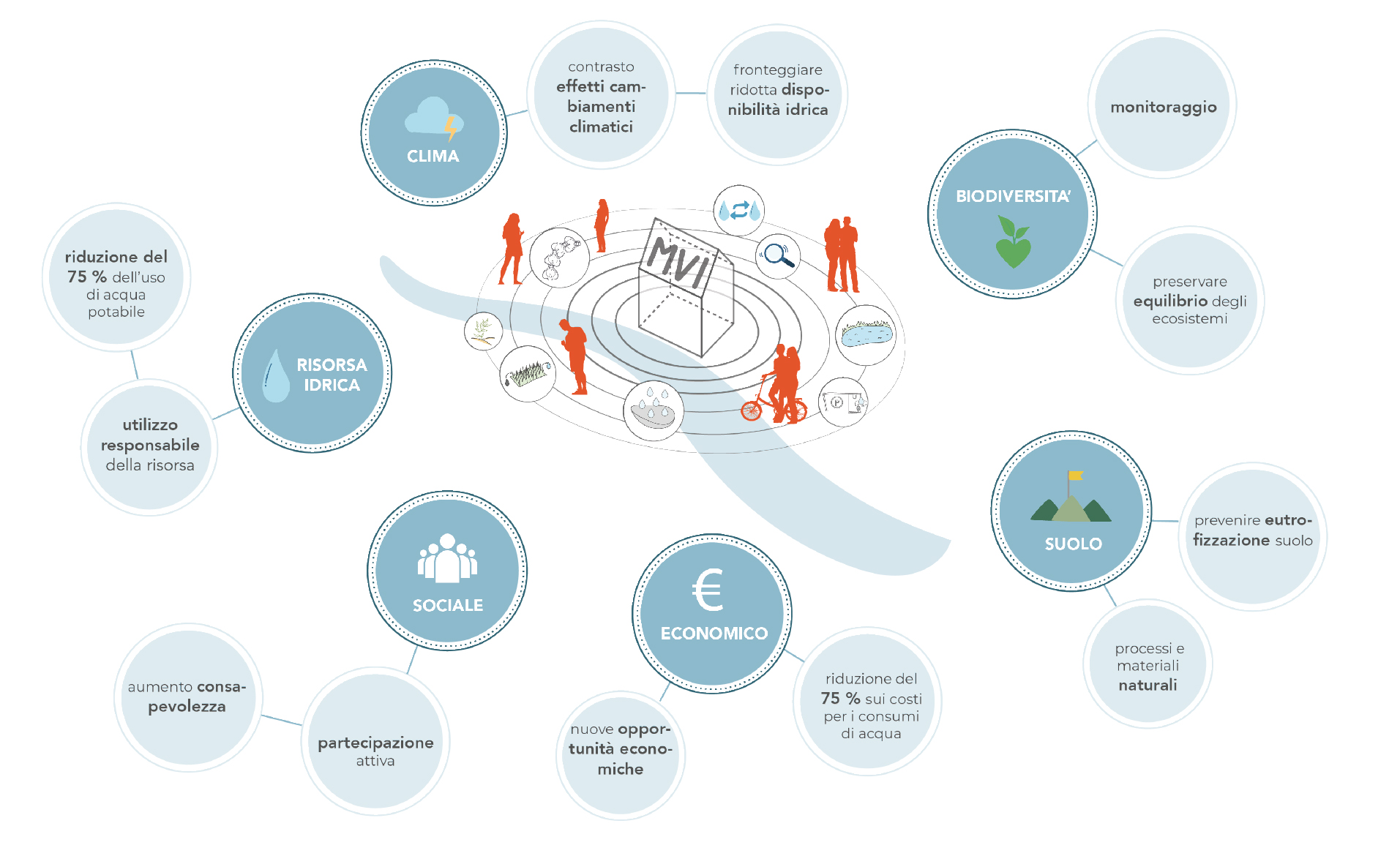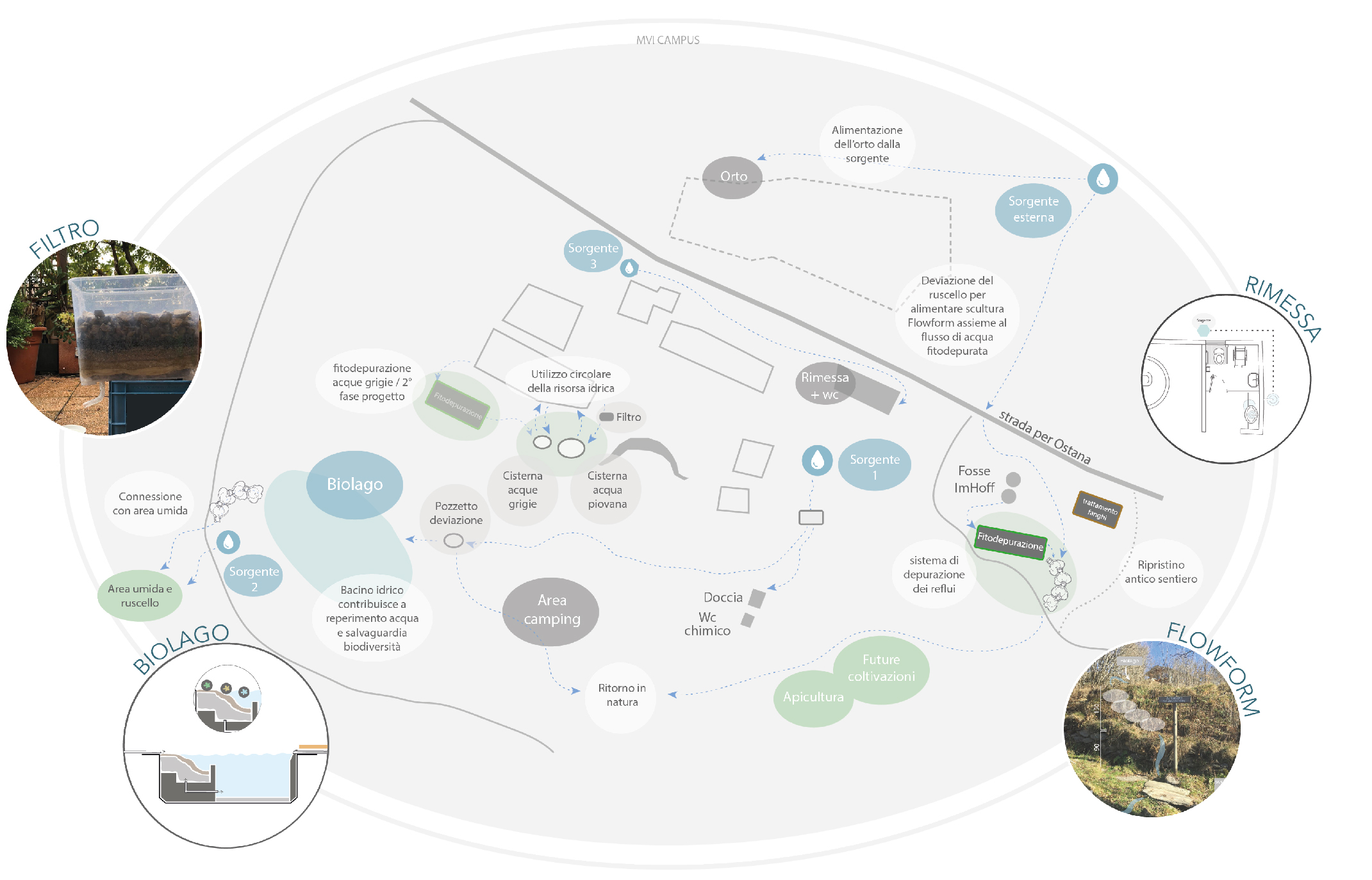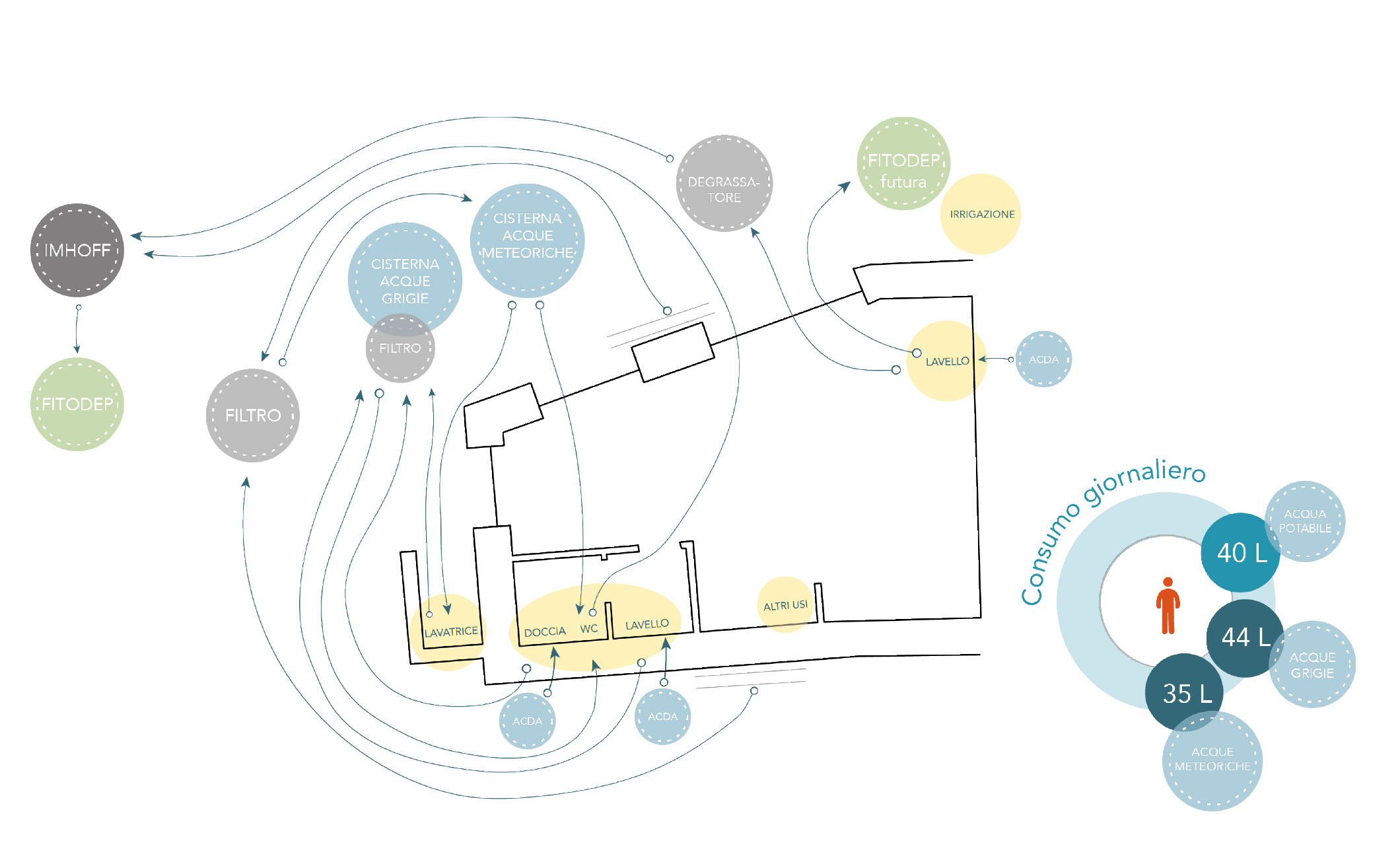Water systemic research
The systemic management of water resources in a mountain environment,
Master's degree thesis in Systemic Design by Carraro Francesca
Having reached the end of my university course of specialization in Systemic Design at the Polytechnic of Turin, I decided to identify a project that could combine my working skills with one of my greatest passions, namely nature and its elements.
The project of this thesis stems from the need to identify a system designed for the management of water resources on the campus of the Monviso Institute, created to be tested by the public, by the research center and born from the need for the development of a new environmental activism, based on consciousness and awareness. The model wants to be conceived as replicable also in other realities, bringing environmental, economic and social benefits.
The project was born thanks to a holistic approach and a systemic design methodology, able to take into consideration all the design details, paying attention to the use of local and recyclable materials, as well as to the creation of value thanks to the interconnections between the designed elements.
After an initial phase of analysis and holistic survey of the campus, an extensive research was carried out on usable technologies, accompanied by a systemic design phase of the same. Thanks to a holistic perspective, the project outlines a water system capable of optimizing the use of drinking water and preserving the ecosystem in which it is inserted through the use of natural technologies designed with an integrated approach capable of exploiting the purification capacities of nature and relating local actors, traditions and materials.
Each element has been studied in detail about its functionality and interaction with the entire integrated system, generating a network of connections and practices aimed at the correct use of the water resource and preservation of the related ecosystem services.

What turns out to be the constant necessary for the replicability of the project is certainly the awareness of the resource that is studied in this paper. In fact, water must be perceived as an integral part of the ecosystem, a natural resource and a social and economic asset, no longer as a detached and separate element. It is important to understand its qualitative and quantitative aspects through monitoring actions, improving the efficiency of its use, applying responsible conservation and minimizing the waste related to it, without neglecting the correct use of the landscape and the soil, equally important aspects capable of playing a decisive role in the management and abatement of pollution and eutrophication of soil and water. The integrated management of water resources should take on a level of worldwide acceptance, thus leading us to start from small local realities following the famous motto quoted by René Dubós: “Think globally, act locally”. Starting from the Monviso Institute, the aim is to spread awareness of the urgency of a virtuous change towards a responsible and systemic relationship between man and natural resources, a pillar of sustainable and permanent social and economic development.

The water problem

The progressive water scarcity worldwide raises issues related to the appropriate use of the resource and its close correlation with the mountain areas, the main suppliers of water also for the rest of urban areas, paying particular attention to the need for responsible and conscious management .
In fact, it is necessary to consider the good governance of water in the mountains not only as a fundamental pillar for environmental protection and sustainability in the use of natural resources, but also as a decisive element for social, health, economic and productive well-being, determining factors for the sustainable development of a nation and the quality of life of its population in the long term.

The project at the MVI
The designed system includes:
- Circular reuse system of water resources in the home
- Collection tanks for rainwater and reuse of gray water
- Flowform sculptures for the remineralization of water
- Biolago as an important source of water finding and safeguarding alpine biodiversity
- Constructed wetland system for waste water from septic tanks for gray water
- Purification filter made with local material
- Garage design and external service
- Green areas such as strong circular reuse and removal of harmful insects
- Workshop for the creation of personal care and house tools made with materials from the campus, at km 0 and natural.
The entire design of the system is concerned with using the resources present, joining them to the system in a natural and respectful way, releasing them in nature undamaged.
House water system

Focusing on the problems related to the use of water resources inside homes, it is appropriate to highlight the percentages of water consumption in the home and what are the uses that, due to hygienic-sanitary regulatory restrictions, must use drinking water to be carried out.
From an ISTAT research on domestic consumption, it emerges that the uses differ in two almost equivalent halves: those that necessarily have to come into contact with the inhabitants and those uses in which this does not happen, for which the use of non-potable water.
Starting from this data, it was my duty to investigate how the water used in homes could be differentiated and where it could be found.
One solution was to use rainwater. In fact, rainwater is very useful for uses in which water does not come into direct contact with humans and therefore must not be drinkable by law.

Precisely for these reasons, the possibility emerges of deviating from today's use of water, exploited everywhere and for every type of use. To do this, a rainwater collection system and a gray water retention device have been designed, to optimize the recycling of the resource and use other sources of supply where possible, studying a water management system in the home through a design systemic.
By implementing the proposed model, a reduction in drinking water consumption from 160 liters per day to an indicative average of about 40 liters is estimated, obviously to be added to the use of 44 liters of gray water and 35 liters of rainwater.
This is made possible through the use of:
- Jet reduction systems
- Rainwater storage systems
- Gray water reuse systems
- Purification systems
A natural swimming pool in the campus: the bio-lake
Going into detail about a couple of these technologies, especially in purification systems, it was decided to install a natural and bathing lake within the grounds of the Monviso Institute. This element represents a very important factor for local biodiversity and for the availability of water in case of fire in the area. The humidity of the valley in fact suffers in particular from the progressive climate change, visualizing the decrease of wetlands and therefore natural environments necessary for the protection of local biodiversity.
The campus has a large area, but the lake was designed to cover an area of approximately 90 square meters. The design started from the need to create three distinct areas of the natural pool:
- bathing area
- area for phytodepuration
- walkable area
For water purification, the integrated phytodepuration system was chosen, where it is possible to recreate a circle of water without the use of a pumping system. In fact, in the construction of a bathing bio-lake, biocompatible engineering techniques are used, avoiding overbuilding interventions. By adopting a sustainable approach based on the principles of the circular economy, natural materials such as stone and wood were preferred for the construction of the constituent elements, fully embracing the philosophy of the Monviso Institute and recovering them on site, using waste stones and advanced wood from recent renovations, ensuring an organic effect with the surrounding environment and a methodology that is careful to maintain a reduced waste.
Given the location of the bio-lake, the problem linked to the rigid temperatures with which the selected plants have to deal with is evident. In fact, native solutions have been sought and used to an alpine environment, resistant with deep and well developed root systems, a high growth rate, non-toxic or pests and aesthetically appreciable. A key feature was to take into account the possible reuse of flowers and leaves of the aforementioned species. Embracing the philosophy of the Monviso Institute, and of systemic design, the possible use of vegetation waste for the creation of products directly on campus, through internal production, or the organization of structured workshops to spread principles of circular economy, is considered important. to guests and outsiders.
The water that supplies the bio-lake comes from the main source within the land of the Monviso Institute, selected among other data the volumes of water flow detected. The source is connected to the bio-lake through a diversion system for the course of the river, which branches off to a diversion pit. The water that comes out of the bio-lake is destined to join the humid area adjacent to the land of the Monviso Institute. The action is fundamental and of great environmental importance, contributing to the preservation of the biodiversity of the wet area under consideration.
The entire water management, also in the design of the system linked to the management of the bio-lake, was based on the principle of the correct and responsible use of the water and the springs, which were included in the project without any purpose related to the exclusive consumption. of the resource. In fact, the water passes through the bio-lake, is used, purified by the phytodepuration system and the flowform sculpture, and is then poured back into nature.

The black water treatment system
All the waters used within the campus are treated within it.
In particular, the black waters (ie those coming from the toilets) are conveyed through long pipes up to two septic tanks. Here the first wastewater purification process takes place slowly, composing the waste and dividing it into solid and liquid materials. The liquid one, after the capacity level of the pits is exceeded, is generally poured into nature or into a river body. This practice, admitted by law, is extremely harmful for the territory. In fact, in the waters coming from the septic tanks there are nitrates, phosphates and other harmful components, which when pouring into the soil involve a progressive eutrophication of the same. In this regard, a natural and inexpensive purification system was designed to be placed after the septic tanks, to purify the water that comes out of them.
The chosen purification system is a phytodepuration plant. This technology provides that the waste water is purified through the use of a waterproofed basin, in which different gravel and vegetable layers purify the water as it flows into the gravel bed, coming into contact with the roots of the plants inserted in the system. . The constructed wetland system is also interesting because the pollutants present in the water are extracted without the use of additional energy and electromechanical parts, encompassing technology and ecology.
In the design of the water management linked to the purification of waste water, the importance of the return of the aforementioned waters to nature was taken into consideration, but emphasizing the ability of the selected plants to improve the conditions of the soil and avoid the overflow of sewage harmful to the environment. The choice to reuse the treated water falls within the guidelines of the project, i.e. they coincide with the creation of a circular system, where the waste of one process is essential to be able to implement another. In this case, the purified and revitalized wastewater from the flowform is rich in nutrients, constituting an excellent water resource for fields and gardens.
Of considerable importance is the position of the plant. It is located a few meters from the Imhoff pits to avoid the installation of pipes that are too long but remaining adjacent to the public path that connects the Monviso Institute and the villages of Serre, Ambornetti and Martino Raso. In this way, the integrated management of the Campus wastewater is voluntarily made visible, exposing the principles of this interesting and useful purification technique for demonstrative and functional purposes.

The research wanted to underline these aspects by treating the case study of the Monviso Institute as a replicable model, inserting the contextualized study in the reference valley. This arises from the need to demonstrate to the local community what the benefits of this paradigm shift can actually be, always bearing in mind that each system is in any case closely related to the context, thus delineating it as a reference case study and not as an invariable model.
The thesis developed on the model designed at the Monviso Institute consists of a multitude of interconnected elements, studied in this paper in a detailed and contextualized way. In addition to this, we want to emphasize how the breadth of the topics covered by the project can generate the development of new areas of research, experimentation and studies, constituting a starting point and a stimulus for proper water management in the mountains.
All that has just been explained is just a small presentation of the systemic management of water resources in the mountains!
If you are interested and want to know more: